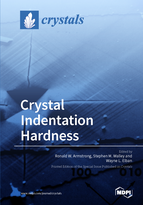Crystal Indentation Hardness
A special issue of Crystals (ISSN 2073-4352). This special issue belongs to the section "Inorganic Crystalline Materials".
Deadline for manuscript submissions: closed (30 September 2017) | Viewed by 124547
Special Issue Editors
Interests: dislocation mechanics; constitutive equations; Hall–Petch relations; Zerilli–Armstrong equations; microstructural stereology; high rate metal deformations; ductile-brittle transition behaviors; X-ray diffraction imaging
Special Issues, Collections and Topics in MDPI journals
Interests: high rate deformation; history of mechanical testing of materials; energetic crystals and polymers
Interests: mechanical properties; indentation hardness; microstructural characterization; historical ferrous metallurgy
Special Issues, Collections and Topics in MDPI journals
Special Issue Information
Dear Colleagues,
Determinations of the indentation hardness properties of crystals have expanded to cover the full characterizations of their important elastic, plastic and cracking behaviors, particularly as accomplished with the increased measuring capabilities of nanoindentation hardness testing. No crystal structure of any bonding type is either too soft or too hard to prevent measurement with a suitable probing indenter. The current Special Issue is devoted to surveying the topic with emphasis given in a collection of reports to: (1) the diversity of crystals being tested; (2) the variety of measuring techniques; and (3) the wealth of information being obtained.
Prof. Dr. Ron Armstrong
Prof. Dr. Stephen Walley
Prof. Dr. Wayne L. Elban
Guest Editors
Manuscript Submission Information
Manuscripts should be submitted online at www.mdpi.com by registering and logging in to this website. Once you are registered, click here to go to the submission form. Manuscripts can be submitted until the deadline. All submissions that pass pre-check are peer-reviewed. Accepted papers will be published continuously in the journal (as soon as accepted) and will be listed together on the special issue website. Research articles, review articles as well as short communications are invited. For planned papers, a title and short abstract (about 100 words) can be sent to the Editorial Office for announcement on this website.
Submitted manuscripts should not have been published previously, nor be under consideration for publication elsewhere (except conference proceedings papers). All manuscripts are thoroughly refereed through a single-blind peer-review process. A guide for authors and other relevant information for submission of manuscripts is available on the Instructions for Authors page. Crystals is an international peer-reviewed open access monthly journal published by MDPI.
Please visit the Instructions for Authors page before submitting a manuscript. The Article Processing Charge (APC) for publication in this open access journal is 2600 CHF (Swiss Francs). Submitted papers should be well formatted and use good English. Authors may use MDPI's English editing service prior to publication or during author revisions.
Keywords
-
indentation hardness
-
nanoindentation testing
-
elastic loading
-
plastic deformation
-
indentation fracture mechanics








